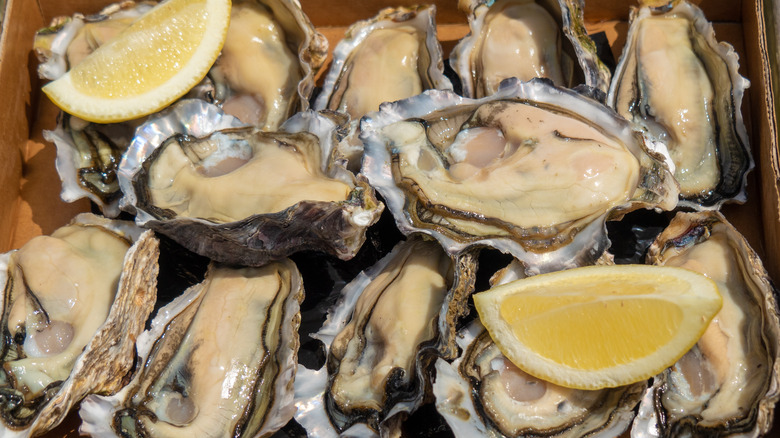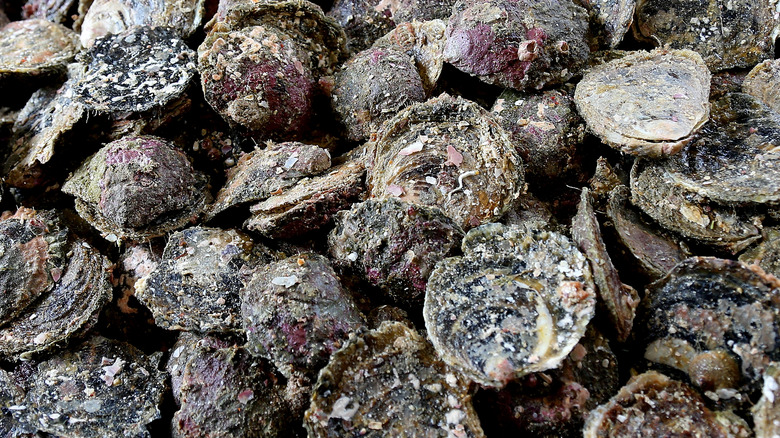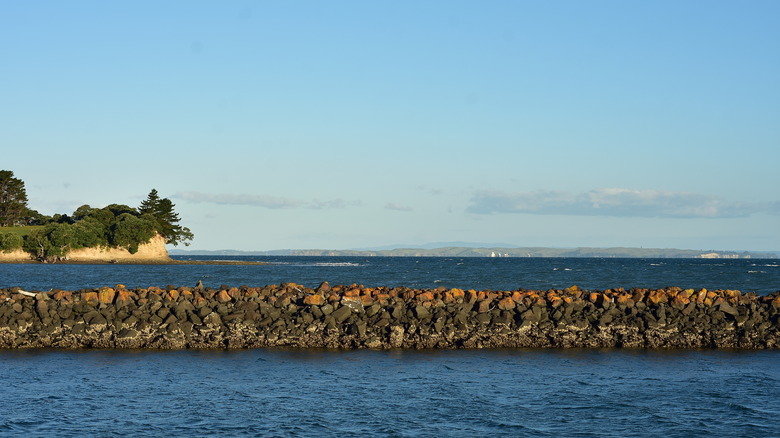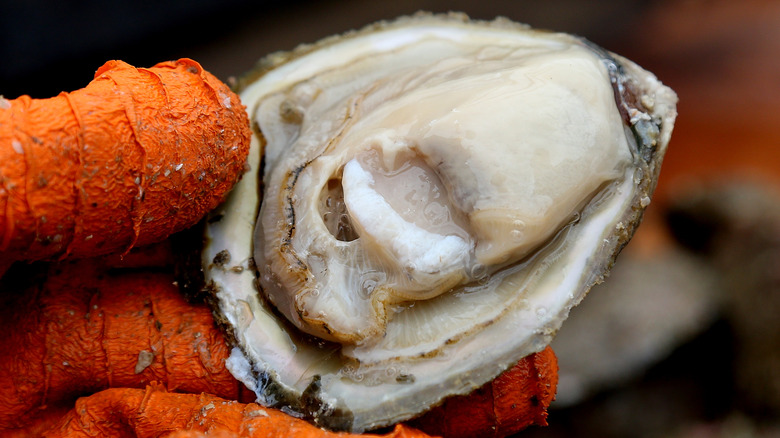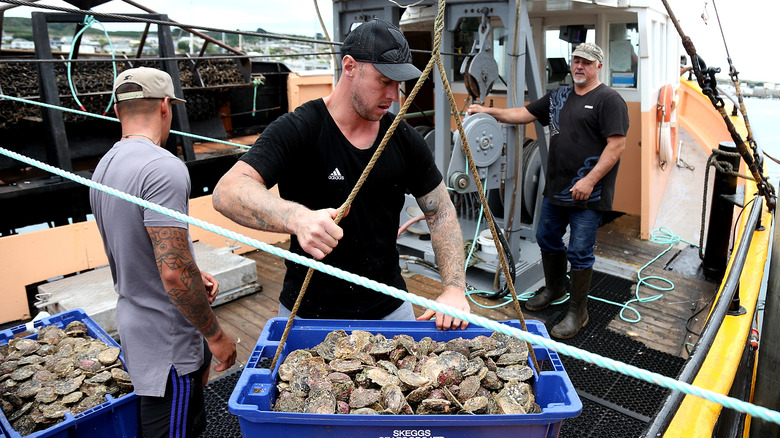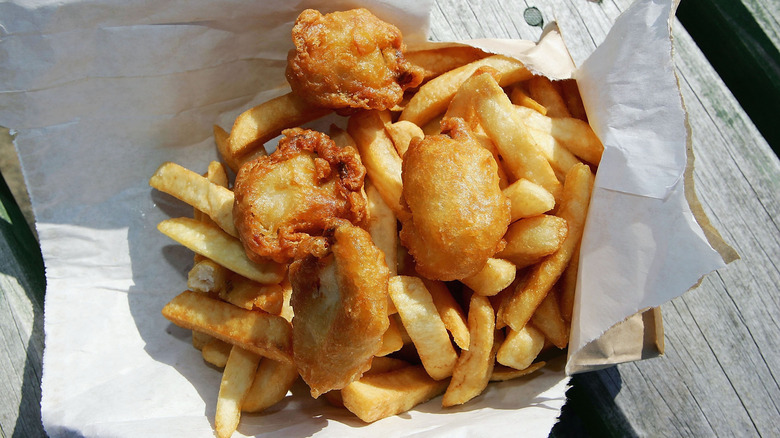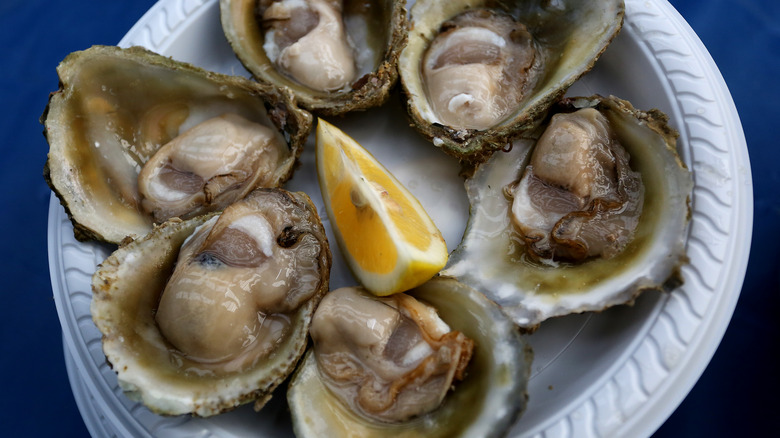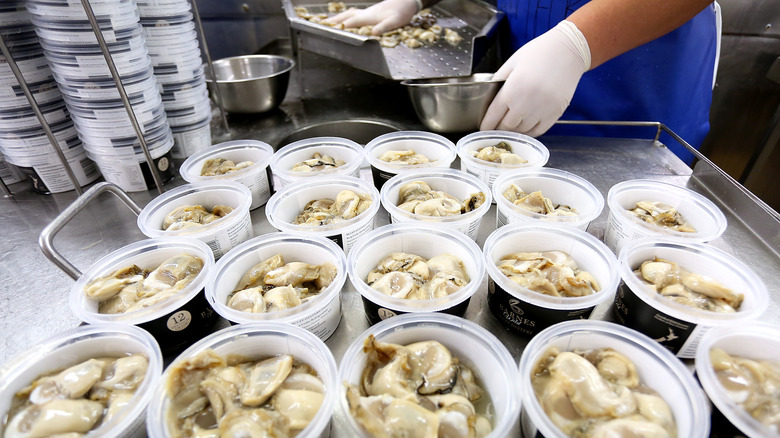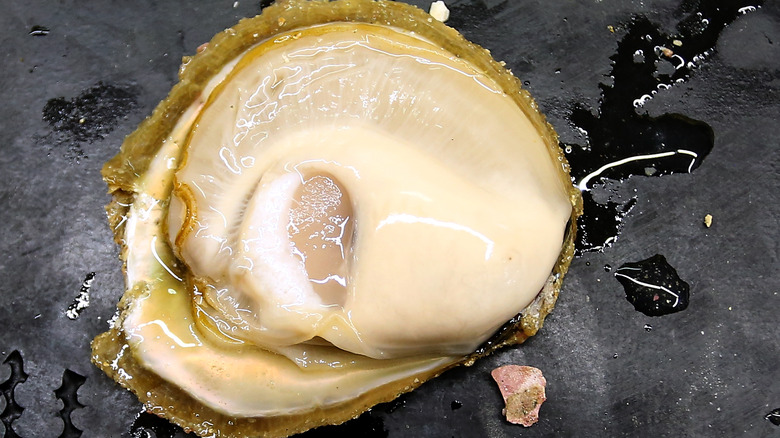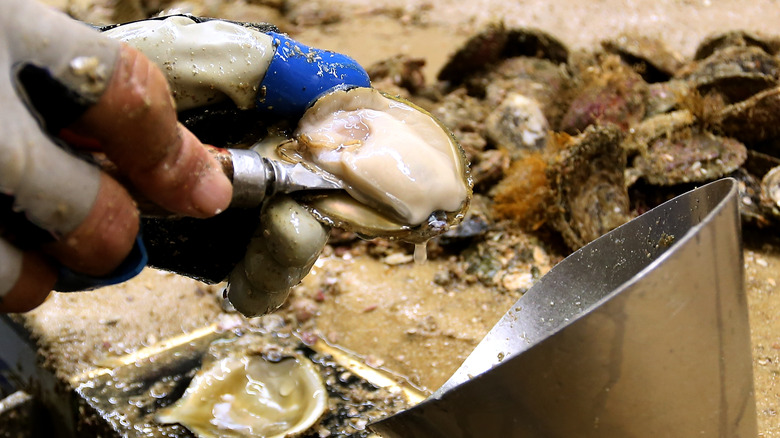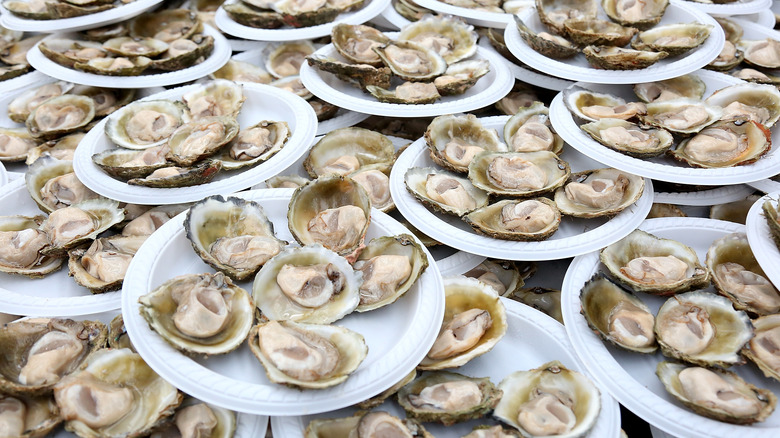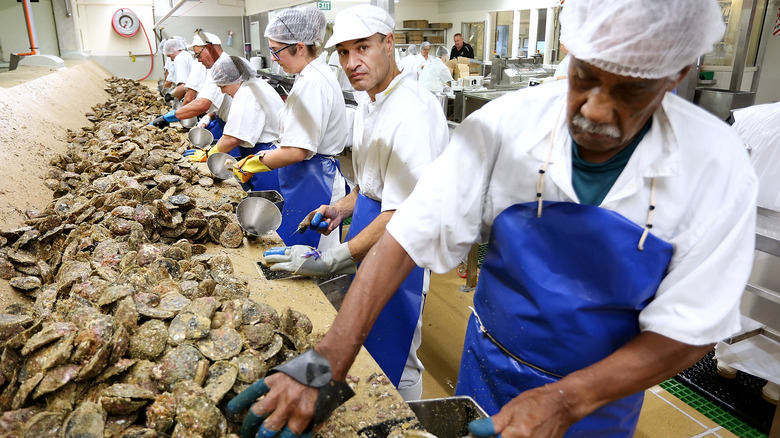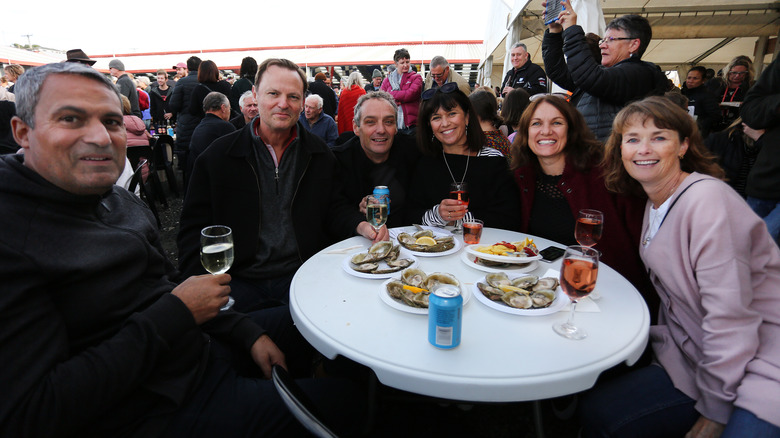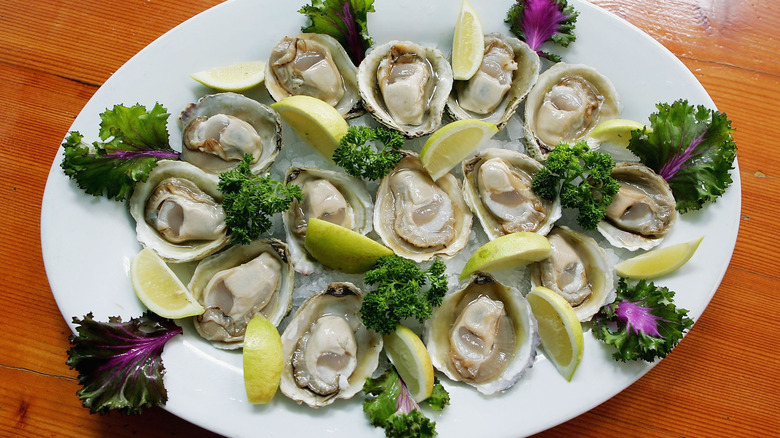What Are Bluff Oysters And What Do They Taste Like?
Most people just call Bluff oysters (Tiostrea chilensis) the best oysters in the world. But, you'll also hear them referred to as dredge oysters, flat oysters, deep-water oysters, mud oysters, and Foveaux Strait oysters, and the Māori know them as tio paruparu. But, what the heck are Bluff oysters? Look at you, coming to the best place to find out everything about them.
For one thing, they're delicious. These itty bitty bivalves didn't earn cult-like international status for nothing. They also pack a whole bunch of history, nutrition, and righteous tradition into a tiny package. A tiny, briny, sweet and singular package whose renowned flavor melts on your tongue like a buttery dream.
Who discovered these things? Is there some kind of oyster beef between "Bluffies" and all the other oysters? And, what kind of party goes down at the Annual Bluff Oyster and Food Festival? We thought you'd never ask. Meet the Bluff oyster, and taste the top prize of New Zealand's salty seas.
New Zealand's national treasure: Bluff oysters
Just off the coast of Southland, New Zealand, (at the southern tip of one of the country's two main islands, South Island) you'll find a wild-growing national treasure beloved for its delicate meat and hallowed harvest season. Nestled in the ice cold waters of the Foveaux Strait, separating the South Island from nearby Stewart Island, live the Bluff oysters – all 10 million of 'em and counting! (There are many more; that's just the usual quota that gets harvested each year once they reach at least 4 years of age.)
This species is native to New Zealand and is also responsible for the flourishing economy there. They're bigger and more flavorful than other types of oysters found in the same waters, and they typically hang out in big crowds tucked into pebbly sand and gravelly ocean floors.
Bluff oysters have been compared to gold, seductive ocean fruit, precious gems, and all kinds of other luxuries ever since fishermen first got together to harvest them commercially in the 1860s. While big fishing made them a household name, they had already long been a treasure fiercely protected by New Zealand's indigenous Māori.
Bluff oysters are an indigenous tradition
Like your oyster legacy to go way back? Y'know, like, back 1,000 years? Bluff oysters just happen to be one of the most beloved of the traditional dishes of New Zealand. And that heritage was born thanks to the Māori who settled on the island around 1250 AD.
Unlike some other non-native foods that were introduced to the island by European settlers (including Potatoes, pigs, and chicken), Bluff oysters were already ripe for the picking. Nestled among other tasty sea creatures like Pāua (abalone) and Kūtai (New Zealand Greenshell mussels), the Māori scooped up Tio (the Bluff oysters) and adopted the shellfish into their daily cuisine.
Some Māori fishermen have been doing the dangerous work of catching these oysters for generations. While you might be able to easily nab a rock oyster in shallow tidal waters around the island while still wearing your flip flops, Bluff oysters like living roughly 150 feet deep at the bottom of the sea.
Bluff oysters vs. the rest of the world's oysters
Any decent oyster could make a big splash in a tiny pond. So, how does the local hero Bluff oyster stack up against the rest of its bivalve cousins? Spoiler alert: really well.
While every oyster serves up a taste of its homeland with a certain sweetness or salinity, Bluff oysters are famous for their plump, sweet meat and an unmistakable flavor that can only be found in the tides of the Foveaux Strait.
Maybe it's because they grow slower and at greater depths than, say, fruity-tasting Pacific oysters or firm and salty Rock oysters — which are also found in New Zealand — that Bluff oysters offer a fuller flavor and a far meatier structure, without a fatty texture. They pack a whole lot of zinc, but also don't taste like a mouthful of metal. Instead, they're soft, creamy, and a little bit salty. As food critic Kim Knight explained to the New Zealand Herald, "The Bluff oyster has more rigour; more power and refinement than its Pacific counterpart which is, literally, sloppier around the edges." If you love oysters, you can't go wrong by straight Bluff-in' it.
The Bluff oyster season runs through New Zealand's winter
The Bluff oyster harvest season is often referred to as being short, despite lasting roughly five months from March through August. But, when you're hunting down a dish that's this in demand, there's never enough time to get your oyster on.
Wintertime in New Zealand hits during the warmer months in the States: June through August. But, those frigid waters of the Foveaux Strait aren't the only natural element the oysters have to beat. Parasites like Bonamia have previously nearly decimated entire populations, and storms have been known to wreak havoc on the vulnerable shellfish. But, despite the odds, the Bluff oysters always return. Thanks to responsible fishing and the loads of research on their environment, Bluff oysters are now the only bivalve species that grow naturally in the wild. As many as 85% of other oyster reefs have been overfished and are now so small in numbers that they classify as being extinct.
Is it worth ditching the teeny summer bikini and heading south of the equator for a wintery shellfish-capade? We don't speak fluent oyster, but it seems like those sweet little Bluffs are calling your name.
Bluff oysters taste like a little pat of butter on a half shell
Eat your oysters however you like. Drown 'em in butter (we highly recommend the compound butter Ina Garten always keeps in her fridge — because, well, Ina), slather them in hot sauce, or send them down the hatch with a spritz of fresh lemon juice. (A million Bluff oyster fans' eyeballs just bugged out reading this. Purists eat them just as they are.)
Go freshly-fished, raw, and right outta the shell. Sweet, soft, super creamy, and salty Bluff oysters need absolutely nothing extra to make them more tasty than they already are. You can add the teensiest squeeze of lemon, if you have to. But, let's not make a half-shell meal out of it, eh?
Pure and simple is the way to go when experiencing the deliciously, briney flavors of the Foveaux Strait. Of course, we do have some ideas if you'd like your Bluff oysters to pack a little heat.
Do you even cook Bluff oysters?
While local fishermen prefer Bluff oysters right out of the sea, during the harvest season, you'll find Bluff oysters all over the island served up in just about every way possible. Find them bobbing around in a creamy Bluff oyster and seafood chowder, battered and fried in a savory Bluff oyster po' boy, or done up Kilpatrick style — a local favorite.
For the not yet indoctrinated, the Kilpatrick method means the oysters are topped with bacon, tomato sauce (or ketchup), hot sauce, and Worcestershire and then grilled or broiled for a few hot minutes. And, breaking news update: That's officially the only way we're eating anything from now on. But, wait! There's more. Pull a Chef Richard Blais, who does his oysters with horseradish pearls. Or, gussy up your shellfish with an authentic oysters Rockefeller presentation loaded with bacon, butter, parsley, and Absinthe.
How do you pick the best oysters to start your dish off on the right note? The craggy Bluff oyster shell is flat on the bottom side, domed on the other, and like a luminescent pearl on the inside. As far as choosing a goodie, we promise by the time you lay your eyes on one, that work will have already been done for you.
Where can you get Bluff oysters if you're not a New Zealander?
Let's get down to brass tacks here. We know what they are, and where they come from, so how do we get our hands on those decadent Bluff oysters if we're not a New Zealand local? Well ... good luck.
Never say never, but not living adjacent to Bluff oysters puts most of us at a disadvantage. Ever since dredging boats first were slapped with quotas in the 1960s (they sometimes voluntarily fish less than the quotas), there have been limits on how many oysters can be sacked every season. Way back when Bluff fishing first began in the 1860s, exportation of the delicacy was banned. Even today, exporting the bivalves remains illegal. The thinking goes that international demand would spike local prices, lead to over-fishing, and quickly decimate the species entirely.
Allegedly, there is talk of someday fishing enough Bluff oysters to (maybe) export a few to nearby Australia. For most of us, these already-spendy oysters will have to come with lodging and transportation, too.
What's with the bluff oyster price tag?
Well, oysters do top the sexiest possible shellfish recipes out there. Despite their sensual reputation, Bluffies demand a steeper price than most. Let's shuck this big ticket tab, "shell" we?
When it comes to drumming up hype, Bluff oysters understand the assignment. They enjoy an abbreviated season, a near-mythological reputation, and limited supply. (Is that the sound of a cash register ringing?) Add to that a season that's possibly cut short for bad weather or an off-year for enough healthy oysters and a smaller catch only jacks up the price even higher. One year, when the season produced just half of the regulated number of oysters, a single Bluff oyster in 2019 went for $20. (With a flute of champagne, but still.)
Bluff oysters certainly aren't the most expensive on the market (that prize goes to the almost $400 per pound Coffin Bay King oyster). But, that's no help when nothing other than Bluffs will do. Typically, you'll find a dozen Bluffies for about $40 — that is, if you can get them before they sell out.
Bluff oysters pack major nutrients in a tiny package
You might be throwing 'em back like a champ, but did you know Bluff oysters pack a whole lot of vitamins and minerals along with that world class flavor? They're delicious and nutritious, and here's the breakdown on just how good they are for you.
You'll be able to taste a little bit of it, but Bluff oysters are poppin' off with zinc, which boosts your immune system. They also serve up Vitamins B12, B2, and B3, which your body uses to break down food and turn it into energy. Also along for the ride are Vitamins C and D, selenium and iodine (which balance thyroid hormones), magnesium, potassium, copper, and phosphorus.
Never mind the wonderfully clean protein content and the bounty of Omega-3 fatty acids for a healthy heart. Can we officially call the Bluff oyster a super-seafood? Maybe. But, while it might fit the profile, this tasty morsel is in a class by itself.
Shuck your Bluff oysters like a pro
If you're lucky enough to shuck 'em yourself, here's the best way to enjoy the party-worthy experience without a side trip to the local urgent care. Go-go gadget, hand-eye-knife coordination!
We're not even trying to pretend we could compete with the seasoned pros who compete in fast-as-lightning shucking competitions during the Bluff oyster harvest season festivals (while blindfolded). But we'd like to think we could shuck our fair share without losing a limb. With an official oyster knife (the kind with the non-slip handle and the short, sturdy blade with the stiff point) in one hand, wrap your opposite thumb in a thick tea towel, placing the oyster on the towel under your wrapped thumb. Gently pry open the hinge of the shell by rotating the knife, then cut the muscle from the top of the shell, then the bottom — and Bob's your oyster.
You can also slap on some snorkeling gear and dive for your oysters yourself. You'll be limited to how many you can collect, but bagging your own Bluffies? Priceless.
Hypothetical: How to store leftover Bluff oysters
Fling open the door to your wildest imagination. Because — at least in this earthly dimension — there is no realistic scenario in which you would ever be in possession of Bluff oysters that you need to save "for later." But — just for shucks and giggles — let's pretend it's possible.
Still-living Bluffies last about a week in the fridge, chillin' in their unopened shells — flat side up — covered with a damp cloth. Don't forget that they also need air in order to breathe, so no sealing them in air-tight containers or fully submerging them in water. If they've already been cracked open, store the half-shells on ice in the fridge for as many as three days. Any period beyond this and all your friends will be wondering if something has broken inside your oyster-loving heart.
Rule of thumb? Eat your oysters fresh from the sea ASAP. They only go downhill from there (they're also kind of sensitive about it, so, y'know ... Bottoms up!)
Bluff oysters are sustainably raised and harvested
Maybe the most magical thing about Bluff oysters is the collective preservation and cultural celebration of the species, which has kept it thriving for generations. But, it takes a village to raise a happy Bluffie.
The roughly two dozen New Zealander boating companies who fish the Foveaux Strait adhere to a limited harvest season and strict regulations on quotas. They've also been known to voluntarily agree to scale down their catch on behalf of the Bluff oysters' benefit. Bluff oysters are also never harvested below standard size (two inches or more) or under age (four to six years). These sustainability practices are monitored closely by the global Fisheries Act as well as New Zealand's fishery-wide Quota Management System.
Thanks to the dedication of the Kiwis as a whole, Bluff oysters still grow in the wild — even in an era where 95% of the world's oyster population is farmed. Does an open sea-raised Bluff oyster taste better than one that grew up on a farm? Is a duck's butt waterproof? Does a whale poop in the ocean? Does a starfish have five legs?
The Bluff oyster lifestyle
Kick back and enjoy the fruits of someone else's labor at the Annual Bluff Oyster & Food Festival in Bluff, New Zealand. Their motto is, "Unsophisticated and proud of it!," and you'll effortlessly adopt the theme: All Bluff oysters, all the time.
The festival happens in May almost every year (location and oysters pending) and gets the party going with a city-wide celebration centered around New Zealand's favorite shellfish. Roughly 4,000 people descend on the town to enjoy the festivities every year, and somewhere in the neighborhood of 20,000 Bluff oysters are eaten during the one-day festival. An "Ode To The Oyster" is performed, there's live music, dancing, a party at every bar and restaurant, a professional (and non-professional) oyster speed-shucking competition, an oyster-eating contest where competitors are chosen from the audience, and plenty more oyster-loving fun. They even serve sweet cinnamon "oysters," a small, clamshell-shaped cake filled with cream and topped with an edible pearl. Bivalves for dessert!
Are Bluff oysters really the best?
Short answer: Yes. Long answer: Hell yes. Anyone who says otherwise has clearly never indulged in the bounty of the Bluff. Just ask any oyster lover who's been to New Zealand.
On Tripadvisor, one reviewer wrote, "Unlike any other oyster [I've] tasted." An Aussie tourist who just happened to pop in on the first day of Bluffie season noted, "The Bluff oysters were bigger than the vast amount of the east coast rock oysters in [Australia]." A new convert from North Carolina recalled, "Those oysters were the single most delicious bites of food I've had in our trip." Another happy oyster devotee declared, "Bluff oysters (currently in season and the only wild oyster left in the world apparently) were phenomenal" (from Tripadvisor).
Two clicks away from booking that trip to New Zealand for Bluff oyster season? Brush up on how to quickly shuck a bunch of oysters and blend in seamlessly with the locals. (No one needs to know about the hot sauce!)

